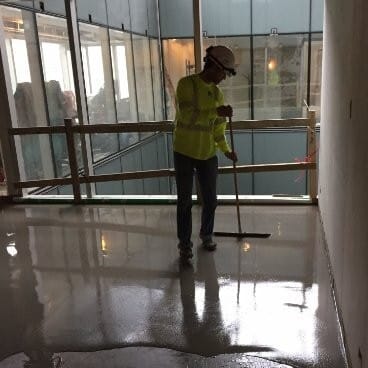
Concrete flooring is made to be durable; its longevity is one of its most attractive features. There’s a lot of concrete can stand up to, from heavy machinery, to heat; it’s even good at dealing with general wear and tear. There are, however, a few different elements that can damage concrete flooring in a variety of ways if it’s not properly treated and maintained. Understanding what these things are can help you better understand what type of flooring you need for your business, and how you should take care of it.
Water
Concrete is a naturally porous material; in fact, concrete is made out of cement, aggregate and water. This porosity means water can easily damage concrete in a few meaningful ways. Water that makes it to the rebar can cause it to rust; this rust will cause the rebar to expand, which in turn can cause spalling and flaking. Water also expands when it gets cold and turns into ice, which can lead to crack throughout the concrete. Finally, water running through concrete can dissolve some aggregates; when sufficient aggregates are dissolved, the water becomes supersaturated, and can leave deposits of these aggregates, which can weaken the concrete. To mitigate the problems caused by water, concrete floors need to be properly sealed or polished to reduce their porosity. Once this is done, while the flooring will not be waterproof, it will be water-resistant.
Chlorides
There’s a chemical called calcium chloride that is often used to reduce the setting time of concrete. This property is quite useful, but in excess, calcium chloride can cause the lime used to make the cement to leach, much in the same way water might cause aggregates to leach. That’s not the only chloride that can cause you problems; the much more commonly seen sodium chloride can also cause leaching. This is of particular importance in Winnipeg, where salts and snow are both commonly tracked onto your concrete floors in the wintertime; caution should be taken so that no excess of saltwater accumulates.
Fire
Concrete is a hit with insurance companies precisely because it’s so resistant to flames; that said, enough fire will damage basically anything. Above 300 degrees Celsius, the water in concrete begins to evaporate, while the aggregate expands due to thermal expansion; this causes internal pressure which leads to the weakening of the concrete. Concrete will change colours when it’s exposed to too much heat; when your concrete starts to turn pink, you know there’s been damage to its overall integrity.
There are a number of other things that can damage concrete, from corrosive chemicals to radiation. Depending on what kind of damage was done, the concrete may need to be repaired or replaced. Your concrete repair company will evaluate whether the damage is cosmetic or structural, and will determine what the best course of action is. When you know your flooring is going to be exposed to concrete damaging substances, it’s a good idea to tell your flooring installer to see if they can coat the concrete with chemicals that will give it more resistance to the elements.

